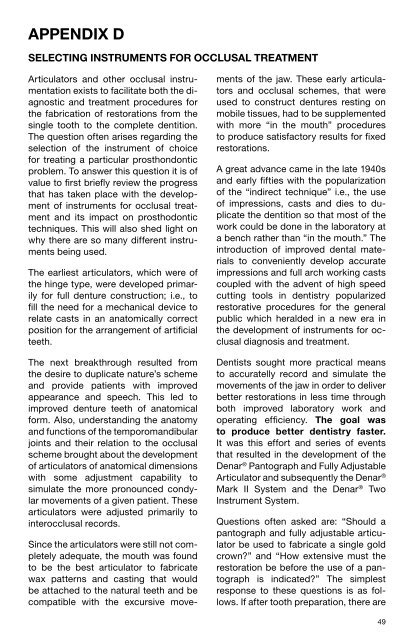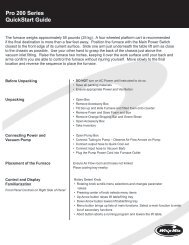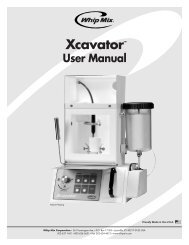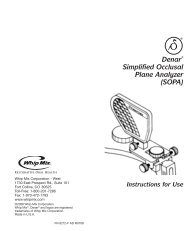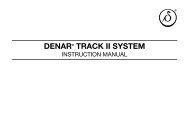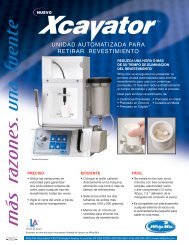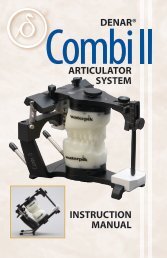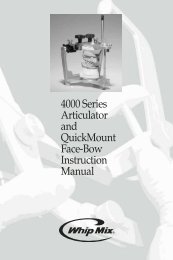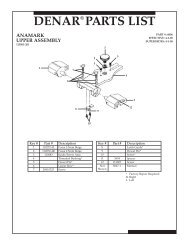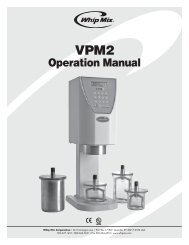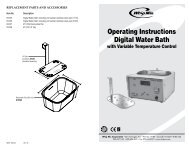Mark II Instruction Manual - Whip Mix
Mark II Instruction Manual - Whip Mix
Mark II Instruction Manual - Whip Mix
Create successful ePaper yourself
Turn your PDF publications into a flip-book with our unique Google optimized e-Paper software.
APPENDIX D<br />
SELECTING INSTRUMENTS FOR OCCLUSAL TREATMENT<br />
Articulators and other occlusal instrumentation<br />
exists to facilitate both the diagnostic<br />
and treatment procedures for<br />
the fabrication of restorations from the<br />
single tooth to the complete dentition.<br />
The question often arises regarding the<br />
selection of the instrument of choice<br />
for treating a particular prosthondontic<br />
problem. To answer this question it is of<br />
value to first briefly review the progress<br />
that has taken place with the development<br />
of instruments for occlusal treatment<br />
and its impact on prosthodontic<br />
techniques. This will also shed light on<br />
why there are so many different instruments<br />
being used.<br />
The earliest articulators, which were of<br />
the hinge type, were developed primarily<br />
for full denture construction; i.e., to<br />
fill the need for a mechanical device to<br />
relate casts in an anatomically correct<br />
position for the arrangement of artificial<br />
teeth.<br />
The next breakthrough resulted from<br />
the desire to duplicate nature’s scheme<br />
and provide patients with improved<br />
appearance and speech. This led to<br />
improved denture teeth of anatomical<br />
form. Also, understanding the anatomy<br />
and functions of the temporomandibular<br />
joints and their relation to the occlusal<br />
scheme brought about the development<br />
of articulators of anatomical dimensions<br />
with some adjustment capability to<br />
simulate the more pronounced condylar<br />
movements of a given patient. These<br />
articulators were adjusted primarily to<br />
interocclusal records.<br />
Since the articulators were still not completely<br />
adequate, the mouth was found<br />
to be the best articulator to fabricate<br />
wax patterns and casting that would<br />
be attached to the natural teeth and be<br />
compatible with the excursive movements<br />
of the jaw. These early articulators<br />
and occlusal schemes, that were<br />
used to construct dentures resting on<br />
mobile tissues, had to be supplemented<br />
with more “in the mouth” procedures<br />
to produce satisfactory results for fixed<br />
restorations.<br />
A great advance came in the late 1940s<br />
and early fifties with the popularization<br />
of the “indirect technique” i.e., the use<br />
of impressions, casts and dies to duplicate<br />
the dentition so that most of the<br />
work could be done in the laboratory at<br />
a bench rather than “in the mouth.” The<br />
introduction of improved dental materials<br />
to conveniently develop accurate<br />
impressions and full arch working casts<br />
coupled with the advent of high speed<br />
cutting tools in dentistry popularized<br />
restorative procedures for the general<br />
public which heralded in a new era in<br />
the development of instruments for occlusal<br />
diagnosis and treatment.<br />
Dentists sought more practical means<br />
to accuratelly record and simulate the<br />
movements of the jaw in order to deliver<br />
better restorations in less time through<br />
both improved laboratory work and<br />
operating efficiency. The goal was<br />
to produce better dentistry faster.<br />
It was this effort and series of events<br />
that resulted in the development of the<br />
Denar ® Pantograph and Fully Adjustable<br />
Articulator and subsequently the Denar ®<br />
<strong>Mark</strong> <strong>II</strong> System and the Denar ® Two<br />
Instrument System.<br />
Questions often asked are: “Should a<br />
pantograph and fully adjustable articulator<br />
be used to fabricate a single gold<br />
crown” and “How extensive must the<br />
restoration be before the use of a pantograph<br />
is indicated” The simplest<br />
response to these questions is as follows.<br />
If after tooth preparation, there are<br />
49


